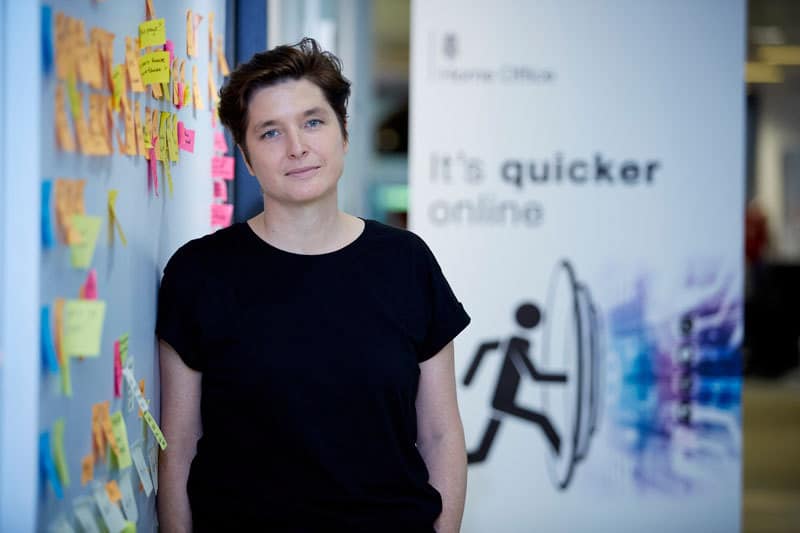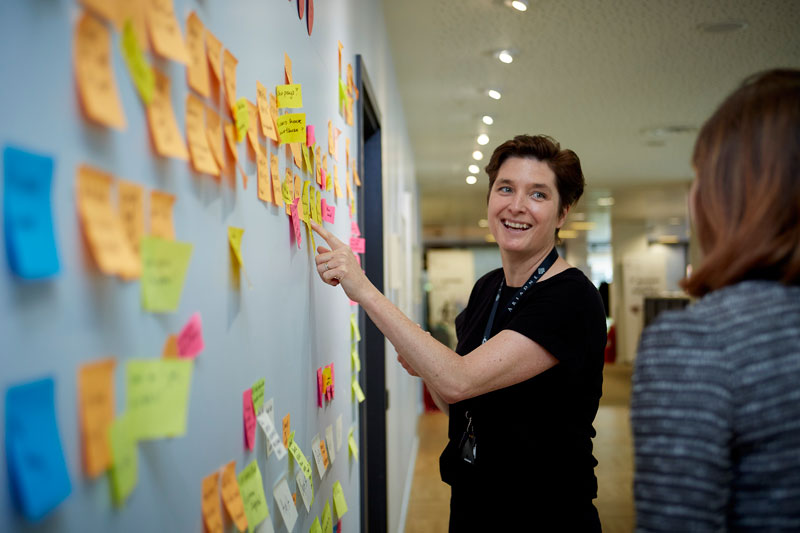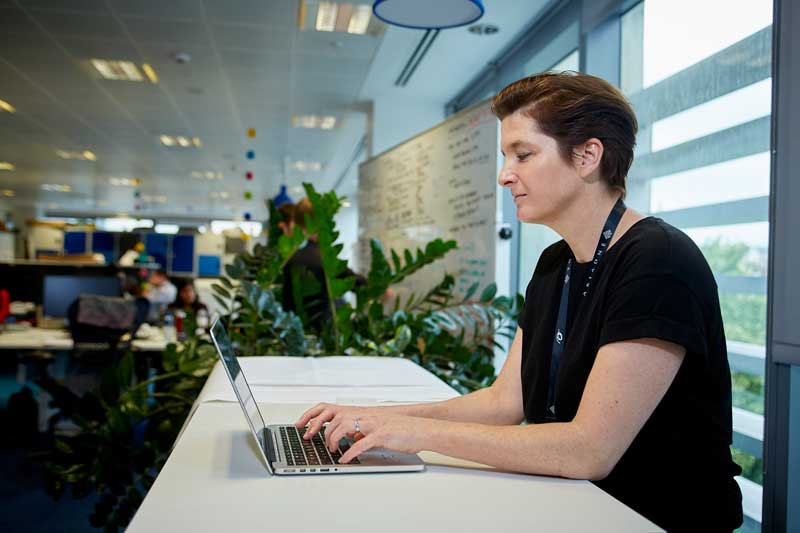
In our latest UX Insider Interview, I talked to Katy Arnold about the changing face of UX at the Home Office and why just getting on and doing things is so important.
Can you tell me a bit about your job title and your responsibilities?
I’ve been Head of User Research and Design at the Home Office since 2014, until very recently when the role changed and it’s just become Head of User Research. But that’s a good news story. My time so far has involved significantly growing and building a team of researchers and designers who are working across multiple projects and in multiple parts of the Home Office.
We’re just at the point now where we’re becoming four specialisms within that family of professions and I’ve spent a lot of time developing what was a very tiny team of what might be described as UX generalists into four distinct specialisms that now have their own heads of profession. We have a Head of Service Design, a Head of Content Design, a Head of Interaction Design and then myself as Head of User Research.
I think that releases us, and certainly releases some of my time, but it will allow the wider digital, data and technology community to really benefit from what those different professions can add. It’s been two and a half years of work to get that in place and I’m really pleased to say that I’m only the Head of User Research now.
How would describe what you’re responsible for within that role?
I’ve spent a lot of time recruiting researchers and designers, which has been one of the most important parts of the role to date. Government has been set on a new path by Government Digital Service (GDS) and we are now actively recruiting digital talent across all the professions, to come into government and work with us to build the services in-house.
It’s a radical departure from what was happening before, where things were largely outsourced in very big contracts to IT giants. Now the emphasis is very much on building these capabilities within the department and within government to have control over them. We end up owning the risk regardless of whether we outsource technical and digital delivery, so hiring specialists who are highly skilled and motivated to work with us has been key.
Training and development has also been important and we’ve put a lot of effort into establishing an internship programme, which is doing remarkably well. It’s a very attractive, paid internship where people get the opportunity to pair with industry experts allowing them to learn, grow and absorb. Our commitment is to get them to a level where they could apply for a junior role.
As well as that, I’m looking at how we work and best practice. That involves linking up with people at GDS, other heads of research and other research teams across government, and defining how we want people to work here. That’s important because it does seem to be different enough to the common experience in the private sector that it’s helpful for both very experienced people and those early in their careers to have some clarity around what good looks like.
We believe that bringing the people who are using services face-to-face with the people who are making those services is the best way to make good services.
The natural question leading on from that is what sets you apart?
I think one of the things that really sets us apart is that user research is involved strategically in government in a way that I’ve rarely come across outside of government. We feed into and inform decisions on a strategic level around public service provision, so rather than just thinking about improving a digital application, or a digital service or a website, we’re looking at the whole end-to-end service.
We do a lot of contextual research with real people. We believe that bringing the people who are using services face-to-face with the people who are making those services is the best way to make good services.
The other way that we differ is that we build things for everybody – you can’t get your passport anywhere else. We’ve got a huge drive around things like accessibility and assisted digital. We probably over sample those at the extreme edges of our society because we know that if you make a service work for people with access needs you’re going to make it better for everybody else.
If we want to move everything the government does into the digital sphere we have to make sure that it works for everyone. We’re not making a fizzy drink or a car website, we’re building things that fundamentally impact how people live their lives. There’s a huge responsibility that comes with that and we take it really seriously.
You don’t have the commercial aspect that some UX leaders will have, like sales, conversions etc. What metrics do you have to measure success?
We talk in terms of failure waste. By that I mean if a service is failing to meet the needs of the people who use it, you tend to see it come out in other areas and that’s what we look for, and how we measure what we’re doing. Such as when people don’t submit enough information for us to make a decision about their application. That can cause extra work for our staff, which we call failure waste. Reducing that extra work can be used as a measurement for success.
At times that can be really hard to do though, because the analytics data doesn’t exist in an easy format. We are working on improving the analytics side of things, because at the moment we’re building a lot of internal tools for staff. That means we can build tools that we can plug analytics into in a way that hasn’t existed before. We’ll be able to be a lot more accurate about measuring how live services are performing and also looking at how changes to those impacts elsewhere in the organisation.
The other advantage of building these tools in-house is that it’s helping us generate a lot of culture change because we’re involving the civil servants who use the tools in the design and build of them, which is a first. We’re generating a level of engagement with transforming government that’s never existed before.

User research is quite a big term. Can you break that down into what methods and tools you mainly rely on?
We rely predominantly on contextual research, contextual enquiry, interviews and usability testing. Our researchers will be, for the main, involved in two core activities.
One of those is carrying out really broad, expansive discoveries; thinking about big problems with services that maybe touch multiple bits of the Home Office, or multiple bits of government, which is always going to be complicated. In those sorts of discoveries we ask researchers to carry out as much contextual enquiry as possible. Interviews, ethnography and observation are the main tools.
We have another broad set of activities that start once we’ve kicked off a delivery team to work on a product or an element of a service. Those researchers tend to spend a lot of their time usability testing. They will work with a content designer and an interaction designer, usually within a delivery team, to test and refine in a rapid, iterative cycle using html coded prototypes. We’re trying to make the whole process as simple and easy as possible, where the user knows what information and answers to give us to enable our staff to make appropriate decisions and be confident in those decisions.
One other core thing is collaborative working, which is something you maybe don’t get in the private sector. We have a saying that there is no UX in government, which means there’s no one person whose role it is and whose responsibility it is to think about the user experience, that’s the responsibility of the whole team.
The other element of that is if everybody’s responsible, everybody gets involved in the research and design process. We get teams to come along and observe research and to take part in those research activities. We also involve them in the analysis, because we’ve found that’s a far better way to embed knowledge than writing a big report that no one will read. Timewise, it’s far more efficient to involve the team in what’s happening and embed that knowledge quickly.
I think that the core thing we’ve done is to create something that people want to be part of and although this is linked to the great work GDS have done, at the Home Office that’s involved creating the design specialisms, and then having the specialisms within research.
When it comes to recruitment, how do you find the right people and attract the right talent to your teams?
This is a really exciting and interesting time to work in digital government. Our offer is quite unique and I think that really stands us in good stead.
Being able to influence policy and have a seat at a strategy level isn’t something that you often get the chance to do. And given that it’s such an important thing to work on, the job satisfaction levels go through the roof. It also makes it incredibly challenging and hard, because culture change is a hard, long, slow business. But making those changes and seeing them come in as we have is incredibly rewarding.
I think that the core thing we’ve done is to create something that people want to be part of and although this is linked to the great work GDS have done, at the Home Office that’s involved creating the design specialisms, and then having the specialisms within research.
We’ve worked really hard to create functions that are dedicated to access needs research and assisted digital research. What that’s done is provide avenues where people can do something different, such as upskill by working with the access needs or assisted digital research teams.
What sort of things are you working on at the moment?
The assisted digital team are doing some phenomenal work running studies across different cities in the UK. We are testing different offline support models for UK Visas and Immigration to support people who can’t get online. We’re trying things like using existing community groups, webchat, and face-to-face provision in partner organisations.
Another lovely piece of work is Karwai Pun’s series of posters for designers which she created in conjunction with the access needs team. Her thinking was that we’re doing all this stuff for researchers but what about designers? How do we make sure that we design things that are accessible? So she created a series of posters, made them available within government and they’ve received a lot of attention. She spoke at Fosdem 2017 earlier this year, and she’s just done a podcast with Ethan Marcotte about them. We’re really proud of a great team effort on that one.
It’s great that when people find gaps they get on with stuff and we make sure we create a culture of innovation where people are allowed to do that.
I’m mainly working on setting up central teams to support the work of delivery teams. I’m laying out what good looks like, developing training and workshops and creating resources to help them do better work.
What’s the most valuable thing you’ve learned in your time at the Home Office?
I’ve learned so much about my profession, particularly in the way we’ve been able to specialise in things like assisted digital and access needs. Also in the way we have users researchers as well as interaction designers – so you can focus on one or the other. I feel like I’ve learned so much more from that approach than if I’d been trying to be master of many trades in the private sector.
In terms of setting teams up in government the biggest thing I’ve learned is that if someone’s had a good idea, just get on and do it. Very often the reason we’ve been able to set things up and grow at the pace we have is that we’ve done just that. It’s really important to enable people in the civil service to initiate change, be innovative, come up with ideas and do them, even if they make mistakes, because they learn from it, they grow and they do it better next time.
It doesn’t matter what kind of day you’re having, if you go and do some research you always meet some fascinating character who surprises you and it’s an enjoyable experience.
What do you find you’re most passionate about?
Users, people. When you spend a lot of your time talking to people who use government services it’s impossible to not care about what happens to them and how well we deliver those services.
It doesn’t matter what kind of day you’re having, if you go and do some research you always meet some fascinating character who surprises you and it’s an enjoyable experience. Seeing the difficulties users face reminds you that people’s lives are messy and complicated and they don’t fit into process maps. Seeing that is massively motivating.

What’s the hardest part of your job?
Culture change is hard. I think we’re here to do two parts user research and three parts culture change. That might be educating our delivery team and selling the benefits of research and design, or it might be convincing the wider Home Office team. There are over 30,000 people who work at the Home Office and most of them have never heard of user research, so part of our work is bringing those people with us, which means a lot of education, overcoming resistance and understanding why people might be resistant.
That’s made us a lot more organised in how we resource teams. It’s rare that we’ll just put a user researcher into a team somewhere in the Home Office and leave them to it. We’re making sure we have user research leads in each of the key portfolio areas and that we support all of the researchers that are working in those parts of the organisation.
The best way to change culture is to talk to people and show them that there are some really good ways of doing things. We need to show them things we’ve done that are working, saving money and making things simpler, clearer and faster for users, as well as delivering what government wants. It’s a slow process, but when you look back, five years ago the Home Office was a very different place, and I’m really excited to see where it will be in five years time.
What do you think will be different in five years in the way we interact with the Home Office?
I don’t know about the exact timescales but I think it will be much easier, much simpler and much clearer. I’m hoping that some of our initiatives around service design will really be making their impact by then.
Ultimately what should start to happen is an increased level of trust and confidence in dealing and interacting with the Home Office. That could be completing application forms and knowing that you’ve filled out the right one, or getting regularly informed as to what’s going on with your application so you feel reassured that someone’s looking at your case and you don’t have to chase. I think it’s those sorts of elements that we’ll start to build up, and as we start to build a better track record for delivering good public services I think the public’s level of trust will go up, which will be a really good thing. It’s an ongoing process – although I’m not sure whether we’ll have done it in five years.
————
Thanks for reading. If you would like to be interviewed, or you’d like us to interview anyone in particular please get in touch.
You can find Katy on Twitter: @katyarnie, or check out more in our UX Insider series

